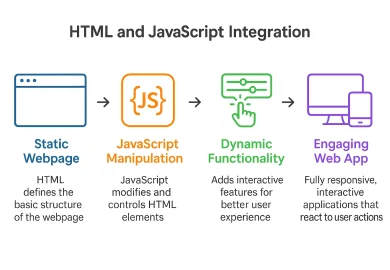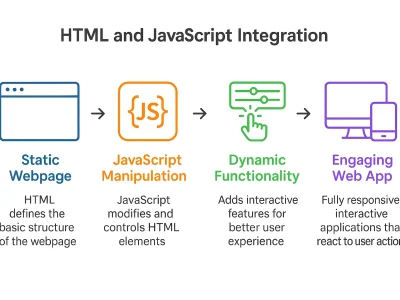In today’s hyper-connected world, businesses and developers face one big challenge: making different systems, apps, and devices work together seamlessly. Customers expect instant updates, smooth experiences, and services that “just work,” but behind the scenes, connecting all these moving parts can be tricky. That’s where APIs step in, acting as the digital bridges that let software talk to each other without friction.
This guide is your complete beginner-to-practical roadmap for understanding APIs. We’ll break down what they are, why they matter in 2025, and how they work — in plain, human language.
What is an API? (Definition & Core Concepts)
Let’s start with the basics. API stands for Application Programming Interface. Sounds technical, but at its core, it’s simply a way for two different pieces of software to talk to each other and exchange information in a structured, agreed-upon way.
Think of an API as a messenger; it takes a request from one system, delivers it to another, and then brings back the response.
The easiest analogy? Picture a restaurant waiter. You (the customer) tell the waiter what you want. The waiter (the API) carries your order to the kitchen (the server), where the chef (the backend system) prepares it. Then the waiter brings it back to you. You don’t have to cook the meal yourself or even see the kitchen; you just get the result you asked for.
Why APIs Matter in 2025
APIs are not just nice-to-haves; they’ve become the backbone of how modern businesses operate.
- Digital transformation enabler – Companies can upgrade their technology without replacing entire systems.
- Business efficiency and automation – APIs remove the need for repetitive manual tasks.
- Innovation and integration – Developers can combine services in creative ways, like embedding maps, payments, or chatbots into apps without building them from scratch.
- Cost-effective development – Instead of reinventing the wheel, businesses can integrate tried-and-tested services through APIs, saving both time and money.
API vs Other Integration Methods
Before APIs became the norm, software systems used other ways to connect each with its limitations.
- API vs Webhooks – Webhooks are like a one-way notification service: they send data automatically when something happens, but don’t allow you to request information on demand. APIs, on the other hand, can both request and send data anytime.
- API vs Direct Database Access – Direct database access gives external systems full entry into your database — risky and hard to control. APIs provide a safer, filtered doorway, giving only the necessary information.
- API vs File Transfers – File transfers (like CSV uploads) work in bulk but are slow and not real-time. APIs exchange data instantly.
- API vs Manual Data Entry – Manual entry is slow, error-prone, and labor-intensive. APIs automate the process, ensuring speed and accuracy.
How APIs Work (Technical Framework Simplified)
Before we jump into the details, think of an API as a conversation between two people who speak the same language. One side asks a question (the request), the other side finds the answer (the processing), and then replies (the response).
The API Request-Response Cycle
Here’s the play-by-play of how an API actually works:
- Client makes a request – This is your app, website, or device asking for something. For example, your weather app says, “Hey API, what’s the temperature in London right now?”
- Server processes request – The API takes that question to the server, which is like the database’s control room. It checks the relevant data, applies any necessary rules, and prepares the answer.
- Server sends response – Once it’s got the info, it wraps it neatly (usually in JSON or XML) and sends it back.
- Client receives and uses data – Your app reads the response and displays it in a way you can understand — in our example, “It’s 15°C and cloudy in London.”
This whole process can happen in fractions of a second.
Key API Components
When you make an API request, you’re not just shouting into the void — there’s structure involved.
- Endpoint URLs – Think of these as the exact “address” you send your request to. For example:
https://api.openweathermap.org/data/2.5/weather?q=London&appid=yourAPIkey - HTTP Methods – These tell the API what kind of action you want:
- GET – Fetch data
- POST – Send new data
- PUT – Update existing data
- DELETE – Remove data
- Headers and authentication – Extra info that travels with the request, like your “entry pass” (API key) or details about what format you want the response in.
- Request and response bodies – The actual content being sent or received. In a POST request, for example, the body might contain the data you want to store.
API Communication Protocols
APIs can “speak” in different styles, depending on the system’s needs:
- REST (Representational State Transfer) – The most common, lightweight, and easy to use.
- SOAP (Simple Object Access Protocol) – A more rigid, rule-heavy format that uses XML.
- GraphQL – A newer, flexible approach that lets you request exactly the data you need — no more, no less. Great for optimizing performance and reducing unnecessary data transfer.
- WebSocket APIs – Built for real-time communication, like live chat apps or stock market tickers. Instead of constantly sending requests, you keep an open connection so updates flow instantly.
Types of APIs and Classifications
APIs aren’t one-size-fits-all. Depending on who can use them and how they’re designed, they fall into different categories.
By Access Level
-
Public APIs (Open APIs)
A public API is like a city park — anyone can come in and enjoy it, as long as they follow the rules.
- Definition & Characteristics:
Public APIs are available to everyone — developers, businesses, and hobbyists. The provider usually shares clear documentation so people know how to use it. You might need to sign up and get an API key, but once you have that, you’re free to start experimenting.
Examples:
- Twitter API
- Google Maps API
- OpenWeatherMap AP
- Benefits & Use Cases:
Public APIs are great for encouraging innovation. Developers can build new apps on top of existing services, businesses can reach more users, and hobby projects can tap into powerful features without starting from scratch. - Getting Started:
Find the API provider’s website, sign up, get your API key, and follow their quick-start guide.
2. Private APIs (Internal APIs)
A private API is more like a company break room — not open to outsiders, only for the team.
- Definition & Characteristics:
Private APIs are built for use inside a company. They let different internal systems talk to each other without exposing data to the public.
- Security & Control Benefits:
Because they’re not public, private APIs can be tailored exactly to the company’s needs while staying behind secure access controls.
- Enterprise Use Cases:
-
-
- Connecting HR software to payroll systems.
- Linking inventory databases to point-of-sale systems.
-
- Development Considerations:
They don’t always need flashy public documentation — just enough for the internal team to understand and maintain them.
3. Partner APIs
Partner APIs are like VIP passes — you don’t give them to everyone, only to trusted partners.
- Definition & Characteristics:
Partner APIs connect businesses to each other. They’re not public, but they are shared outside the company — usually through formal agreements.
- Examples:
-
- Travel agencies using airline booking APIs.
- Payment providers are integrating with specific e-commerce platforms.
Benefits & Opportunities:
These APIs often generate revenue, deepen partnerships, and provide more seamless service to customers.
- Implementation Strategies:
Set up strong authentication, define clear usage terms, and keep an open communication line with your partners.
By Architecture Style
1. REST APIs
The most popular kid in the API world. REST stands for Representational State Transfer.
Key Traits:
- Stateless
- Resource-Based URLs
- JSON Format
Why it’s loved: Simple, scalable, and supported almost everywhere.
2. SOAP APIs
SOAP stands for Simple Object Access Protocol, but don’t let the name fool you — it’s a more formal, rules-heavy type of API.
Key Traits:
- Protocol-Based
- XML Format
- High Security
- Legacy-Friendly
Why it’s used: Reliability, security, and strong standards.
3. GraphQL APIs
The modern, flexible option — GraphQL lets you ask for exactly the data you want and nothing more.
Key Traits:
- Query Language
- Single Endpoint
- Efficiency
- Developer-Friendly
Why it’s trending: Speed, precision, and adaptability.
Real-World API Examples & Use Cases
The best way to understand APIs is to see them in action — not buried in technical diagrams, but in the apps and services we use every day. Here’s how different industries put APIs to work to make life easier for both businesses and users.
Social Media Integration
Ever wondered how apps let you share a photo straight to Instagram, post updates to Twitter (or X), or pull your LinkedIn profile data into a portfolio site? That’s all thanks to social media APIs.
- Facebook/Instagram APIs
- Twitter API
- LinkedIn Integration
For brands, this means less time hopping between platforms and more time focusing on strategy.
Payment Processing
If you’ve ever bought something online and paid without thinking twice, you’ve experienced an API at work.
- PayPal API enables one-click checkout and secure transactions.
- Stripe API goes beyond payments, handling subscriptions, refunds, and multi-currency billing.
- Banking APIs connect apps directly to financial institutions for things like instant bank transfers or account verification.
In e-commerce, payment APIs are non-negotiable — they make transactions fast, secure, and user-friendly.
Maps and Location Services
Anytime an app shows you a map, tracks your delivery, or predicts arrival time, there’s a location API running in the background.
- Google Maps API powers everything from embedded maps on websites to complex route calculations in apps.
- Uber/Lyft APIs track driver and passenger locations in real time.
- Weather APIs integrate location data to show hyper-local forecasts.
These APIs turn raw coordinates into useful, user-friendly features.
E-commerce and Marketplace
Behind every smooth online shopping experience, there’s a network of APIs keeping things in sync.
- Amazon API for Sellers lets vendors manage inventory, track orders, and adjust prices automatically.
- eBay APIs help sellers update listings, process sales, and get market insights.
- Shopify APIs connect stores with apps for marketing, shipping, and customer service.
They’re the reason you can buy something in two clicks and have it delivered the next day without chaos behind the scenes.
Communication and Messaging
APIs are the invisible glue of modern communication tools.
- WhatsApp Business API enables automated replies, notifications, and customer service chats at scale.
- Slack API allows bots and integrations to send alerts, manage tasks, and streamline team communication.
- Email APIs like SendGrid or Mailchimp handle everything from sending newsletters to tracking open rates.
- SMS APIs send real-time notifications, like OTPs and delivery updates.
In short, if a message reaches you instantly and automatically, an API probably delivered it.
Benefits of Using APIs
APIs aren’t just a tech buzzword — they’re game-changers for businesses, developers, and even everyday app users. Let’s break it down from each perspective.
For Businesses
- Faster Development Cycles – Instead of reinventing the wheel, companies can plug into existing APIs and launch features faster.
- Cost Reduction and Efficiency – Why spend months building a payment gateway when Stripe already exists? APIs save time and money.
- Revenue Generation Opportunities – Some businesses monetize their APIs, charging others for access to valuable data or services.
- Better Customer Experiences – Smooth, connected services keep customers happy and loyal.
- Scalability and Flexibility – APIs make it easier to expand services, integrate with new platforms, and adapt to market changes.
For Developers
- Code Reusability – APIs allow devs to build smarter, not harder.
- Access to Third-Party Functionality – Tap into powerful tools like AI, payment processing, or mapping without starting from scratch.
- Simplified Development Process – Less manual coding of common functions means fewer headaches.
- Focus on Core Features – Spend more time on what makes your app unique.
- Faster Time-to-Market – Launch sooner, test ideas quicker, and stay ahead of competitors.
For End Users
- Seamless App Experiences – No clunky switching between platforms.
- Integrated Functionality – Book a ride, pay for it, and get directions without leaving the app.
- Real-Time Data Access – Weather updates, live scores, or instant stock prices at your fingertips.
- Personalized Services – APIs help tailor recommendations, content, and offers.
- Cross-Platform Compatibility – Your data works across devices, from phone to desktop to smartwatch.
API Security and Best Practices
APIs are powerful, but with great power comes great responsibility — especially when it comes to security.
Common Security Threats
- Unauthorized Access Attempts – Hackers trying to get in without permission.
- Data Breaches and Leaks – Sensitive information falling into the wrong hands.
- DDoS Attacks on APIs – Overwhelming the API with traffic until it crashes.
- Man-in-the-Middle Attacks – Intercepting data between client and server.
- Injection Attacks – Sending malicious code through API inputs.
Security Implementation
Authentication Methods:
- API Keys – Unique codes for identifying who’s making the request.
- OAuth 2.0 – The “Sign in with Google” kind of secure authentication.
- JWT Tokens – Compact tokens that store encrypted user info.
- Basic Authentication – Simple username and password (less secure).
Security Best Practices:
- Always use HTTPS encryption.
- Set rate limits to stop overloads.
- Validate all inputs to block bad data.
- Handle errors gracefully — no detailed server info in messages.
- Monitor and log activity to spot suspicious behavior.
Data Privacy and Compliance
- GDPR Compliance – If you serve EU users, you must follow strict privacy laws.
- Data Protection Measures – Encrypt sensitive data, both in transit and at rest.
- User Consent Management – Always ask before collecting personal information.
- Privacy Policy Considerations – Clearly explain how you use and store data.
API Development and Testing
Creating an API isn’t just coding; it’s planning, building, and thoroughly testing.
API Development Process
Planning Phase:
- Gather requirements — what problem will the API solve?
- Design endpoints and decide how data will be structured.
- Document everything from the start.
Development Phase:
- Build backend logic and connect to databases.
- Implement security measures.
- Handle errors properly.
Testing Phase:
- Unit Testing – Check individual functions.
- Integration Testing – Make sure parts work together.
- Load Testing – Can it handle high traffic?
- Security Testing – Look for vulnerabilities.
API Documentation
Good documentation is like a map; without it, even a great API will get lost.
- Use tools like Swagger or Postman to generate and maintain docs.
- Include code examples and step-by-step guides.
- Keep track of versions so developers know what’s current.
API Testing Tools
- Postman – Perfect for building and testing requests.
- Insomnia – A clean, developer-friendly REST client.
- curl – A command-line tool for quick requests.
- Automated Testing Frameworks – For ongoing, large-scale API tests.
Popular API Tools and Platforms
- Development Tools: Postman, Swagger/OpenAPI, Insomnia, Apiary.
- Management Platforms: Amazon API Gateway, Google Cloud Endpoints, Azure API Management, Kong Gateway.
- Monitoring & Analytics: New Relic, Datadog, Pingdom, or custom setups.
Getting Started with APIs (Beginner Guide)
If you’re completely new to APIs, the good news is you don’t need to be a full-blown coding wizard to get started. With a little bit of programming knowledge and some curiosity, you can start making your first API calls in no time.
Prerequisites and Skills Needed
Before diving in, it helps to have a few basics under your belt:
- Basic programming knowledge – You don’t need to build the next Facebook, but understanding variables, functions, and loops will help you read and write simple API scripts.
- Understanding of HTTP protocols – This is the “language” of the web. Knowing the difference between GET, POST, PUT, and DELETE requests will make API documentation less intimidating.
- JSON/XML data formats – APIs often send and receive data in JSON (easy to read) or XML (a bit more structured). You should be able to recognize and navigate both.
- Command line basics – Being comfortable running a few terminal commands will help, especially if you’re testing APIs with tools like curl.
Your First API Call
Making your first API call feels a bit like sending your first text message to the internet and getting a response back. Let’s break it down.
Step-by-step tutorial:
- Choose a simple public API – Pick something fun and free, like a weather API, random joke API, or “quote of the day” API.
- Make a GET request – This is you asking for data. You can do this in your browser (just paste the API URL) or in Postman.
- Understand the response – The API will return data, usually in JSON format. Learn to read it like a story — each field tells you something.
- Handle errors – Sometimes the API will say, “Nope, can’t do that.” Learn to read error codes like 404 (not found) or 401 (unauthorized).
Practical exercises:
- Weather API integration
- Currency exchange API
- Quote of the day API
- News API implementation
Building Your First API
When you’re ready to go from using APIs to creating one, here’s your roadmap:
- Set up your development environment – Install Node.js, Python, or your preferred language setup.
- Create simple REST endpoints – For example, /products to show items or /users to list people.
- Connect to a database – So your API can store and fetch real data.
- Test and deploy – Use Postman to test, then push your API live with a service like AWS, Azure, or Vercel.
Suppose you want to connect your app with a weather API. You can send a request and get real-time weather data as a response. To simplify this process, developers use platforms such as Postman for testing and documentation
API Trends and Future in 2025
APIs aren’t just tools anymore they’re shaping how the digital world works.
Current API Trends
- GraphQL adoption growth
- Serverless API architecture
- AI and ML API integration
- Real-time APIs and WebSockets
Emerging Technologies
- API-first development approach
- Microservices architecture
- Event-driven APIs
- Low-code/no-code API builders
Industry Evolution
- API economy expansion
- API monetization strategies
- Developer experience focus
- API standardization efforts
Common API Challenges and Solutions
APIs are powerful, but they’re not problem-free.
Technical Challenges
Performance issues:
- Slow response times
- High latency
- Bandwidth limits
- Difficulty scaling under heavy loads
Integration difficulties:
- Version mismatches between systems
- Different data formats
- Authentication complexities
- Poor error handling
Business Challenges
- API strategy planning
- Cost management
- Vendor dependency
- Compliance requirements
Solutions and Best Practices
- Caching strategies
- Load balancing
- API versioning
- Comprehensive testing
API Career Opportunities
If you know your way around APIs, the job market in 2025 is wide open.
API-Related Job Roles
API Developer
- Builds and maintains APIs.
- Skills: coding, database knowledge, cloud platforms.
- Salary: Competitive in both startups and enterprises.
API Product Manager
- Oversees API strategy, documentation, and partner relations.
- Balances technical and business needs.
DevOps Engineer (API Focus)
- Ensures APIs run smoothly, securely, and efficiently.
- Manages deployments and monitoring tools.
Skills Development Path
- Programming languages – Python, JavaScript, and Java are great starting points.
- Database management – SQL and NoSQL systems.
- Cloud platforms – AWS, Google Cloud, Azure.
- API tools – Postman, Swagger, Insomnia.
Conclusion: APIs as the Future of Digital Connectivity
If there’s one takeaway from everything we’ve covered, it’s this: APIs are the glue holding the modern digital world together. If you’re just starting, my recommendation is simple: pick one simple public API and play with it. Make a request, read the response, and see the magic for yourself. From there, exploring and creating your basic API, even a simple one that serves a list of products or daily quotes, can teach you a lot.
As for the future? The API economy is only getting bigger. The more you understand, the more opportunities you’ll have, whether you’re building products, growing a business, or shaping the next generation of digital experiences.
Understanding APIs is the first step to becoming a better developer. To see real-world applications, check out our MERN Stack resources and start building projects today




